Misc
HORROR 101: The Texas Chain Saw Family Trees

Welcome BACK to Horror Press’s Horror 101, a series of articles where we explain horror movie legends and their lore. For beginners, the confused, or just those who need a refresher, these articles are for you. Today, we’ll clear up the record on one of Texas’ bloodiest families, the Sawyers from the Texas Chainsaw Massacre series (and their remake counterparts, the Hewitts). It’ll be a rough ride to get to the bottom of who they are, why they kill, and how they developed their…particularly peculiar diet.
We won’t be delving into the David Blue Garcia 2022 requel much this time or that reboot trilogy with Leatherface and Texas Chainsaw 3D. Instead, we’re focusing on the longest-running series, which we’ll call the mainline continuity (that’s the original, Part 2, 3, and The Next Generation), and the remake duology (the 2003 remake and Texas Chainsaw Massacre: The Beginning) which shares some similarities. See the handy dandy chart courtesy of Bloody Disgusting for a proper timeline breakdown.
So, get to the back of the pickup and ensure you got your chainsaw filled with gas. Or make sure the battery is charged if you’re one of those eco-conscious city types!
Who’s up for a field trip to Texas?
WHO ARE THE SAWYERS?
The people who make Leatherface who he is, the Sawyers (originally named the much less subtle “Slaughters” in the script), are a cannibalistic family with more quirky and colorful members than you can shake a stick at. Their M.O.? Luring victims on the land around their home so they can toy with, kill, and eat them.
Most of their rituals and behaviors are a perversion of the traditional nuclear family, with the most infamous being their prolonged and exhausting dinners in which they relentlessly mock their targets and relish their suffering through torture.
Possibly with or without literal relish.
In Texas Chainsaw Massacre and Texas Chainsaw Massacre Part 2, the immediate Sawyer family is comprised of:
- Standing patriarch, father, and award-winning chili cook Drayton Sawyer not-so-standing living fossil, Grandpa Sawyer
- Deranged hitchhiker, Nubbins Sawyer
- Nubbin’s twin brother, army veteran, and music lover with a skull plate, Chop Top
- And, of course, titular chainsaw wielder and mask maker Bubba “Leatherface” Sawyer
AN ALL NEW FAMILY FOR THE SEQUELS
There’s also Grandma Sawyer, a chainsaw-holding corpse shrine in Part 2 with no living appearances. Though…this crew is all dead by the end of Texas Chainsaw Massacre 2 (except for Leatherface, depending on your interpretation). At the film’s end, Chop Top was supposed to have survived his scuffle with Stretch. However, this was a plan for the unmade short-film All-American Massacre and never came to fruition, so its canonicity is dubious at best.
Leatherface: Texas Chainsaw Massacre 3 shows us a new family, which includes:
- Suave faux cowboy, Eddie “Tex” Sawyer
- Mechanical genius, Tinker Sawyer
- Peeping Tom, Alfredo Saywer
- Leatherface’s unnamed daughter, who is credited in some places as Babi Sawyer
- And Leatherface’s mother, Anne Sawyer
Texas Chainsaw Massacre: The Next Generation rounded us out with only three more official Sawyers: the pretty u nremarkable W.E. Slaughter, a brand-new impostor Grandpa, and extended family member with robot legs, Vilmer Slaughter.
WHO ARE THE HEWITTS IN THE TEXAS CHAINSAW REMAKE?
The remake duology introduced a new version of the family. The Hewitts are distinct from the original Sawyers, in that rather than being a campy bunch of freaks, they’re pseudo-religious nutjobs that don’t take much pleasure in what they do. That is, barring our Drayton analog and head of the family, Charlie Hewitt (using the disguise of Sheriff Hoyt), who commands the rest of them with an iron fist and enjoys abusing captives. Beyond him, there’s:
- Surrogate mother to Thomas, Luda-Mae Hewitt
- Her brother, wheelchair-bound creep Monty Hewitt
- The youngest son Jedidiah Hewitt
- Baby thief Henrietta Hewitt and her mysterious cohort, The Tea Lady
- And Thomas “Leatherface” Hewitt
HOW DID THE SAWYER FAMILY BECOME CANNIBALS?
We can lay the blame on one: Grandpa Sawyer.
At the time of the original film, Grandpa Sawyer is about 120, meaning he most likely was born in 1854. As a young man, he became a skilled hand in abattoirs and stood as a renowned butcher; Grandpa was deemed (by Drayton) as once having been the family’s best killer due to these skills. We only ever get to see them on display in Leatherface, the first time he wields his trusty hammer with some level of efficiency beyond flapping his wrist around.
At the turn of the 19th century, Grandpa Sawyer would see the Texan meatpacking industry slowly begin to replace smaller butcher businesses. Due to the speed of the industrialized process, Grandpa lost his job, and soon the family became more insular. The fear of starvation from poverty and general isolation in rural Texas pushed the family to begin the practice.
HOW DID THE HEWITT FAMILY BECOME CANNIBALS?
In the remake duology, the failure of industrialization sets into motion the Hewitt Family’s corruption; newspapers shown in the film mention a local meat packing plant, The Lee Bros. Meat Processing Plant had gone under and left hundreds in town jobless. It closed due to numerous health violations, most likely related to the mistreatment of workers like Leatherface’s mother who dies on the job after stress-induced labor kills her (though a deformed infant Thomas with a skin condition still survives).
Unlike Grandpa Sawyer, Charlie Hewitt introduces his family to cannibalism due to his time in the Korean War, where he picked up the habit as a means of survival. Taken captive in 1952, Charlie and other prisoners were forced to choose among themselves who would be sacrificed to feed the rest. Though they were eventually rescued, this practice awakened something in Hewitt that he would eventually spread to the rest of his kin. This also expands on the anti-war subtext of the original film, as much of The Beginning does.
WHY IS THE SAWYER FAMILY DIFFERENT IN EVERY FILM?
While Part 2 mainly adds Chop Top, a trend pops up in 3 and The Next Generation, where a new version of the family exists to aid Leatherface.
There are a few explanations for this.
One could be that Sawyer progeny are just everywhere. After Sally escapes in the first film, Drayton and company relocate to the abandoned Texas Battleland Amusement Park. However, the Sawyer House in 3 and The Next Generation are also different homes, which may be inhabited by extended family members. By this logic, Leatherface somehow survives his wounds in Part 2 and simply moves from family to family whenever he needs assistance. This theory is backed by the fact that Stretch, the protagonist of Part 2, makes a cameo in 3, looking for Leatherface as a now fully-fledged T.V. reporter.
The more outlandish explanation? The Sawyer Family isn’t a real family.
In Texas Chainsaw Massacre: The Next Generation, it’s revealed that the Sawyers are funded and protected by a shadowy conspiracy, most likely the Illuminati of legend. Their representative even abducts the last survivor of that film to observe the effects of the Sawyer-induced trauma on her mind. It would make sense that whenever Sawyers are killed, the Illuminati simply funnels in new family members to replace them, and perhaps even creates and installs a new Leatherface should the current one suffers wounds too great to recover from (such as the ill-fated chainsaw duel with Lefty at the end of Part 2).
HOW DID BUBBA SAWYER BECOME LEATHERFACE?
The primary explanation for Bubba Sawyer, and Thomas Hewitt for that matter, becoming Leatherface is that their families simply brainwashed them into serving as a grunting, violent attack dog. Abused by their respective father figures, the mentally stunted Leatherfaces came to mimic their violent parentage and ended up as a distortion of the breadwinner by hunting down and butchering innocents for the family.
Hurt people hurt people, you know?
WHY DOES LEATHERFACE WEAR THE MASKS?
Contrary to popular belief, the grisly masks Bubba sports in the mainline continuity are meant to reveal more than they conceal. While human consumption is a matter of sport and sustenance for the rest of the family, Leatherface’s masks are mostly separate from this as a sign of care and craft. They’re used as a reflection of his emotional state.
Gunnar Hansen has mentioned many times that Tobe Hooper’s original intent for the varying masks we see is to reflect how Leatherface feels on any given day. They’re used to make him feel pretty or powerful, and he takes great care in fashioning them. The masks can even function as gifts: in Texas Chainsaw Massacre Part 2, he shares a makeshift mask with Stretch in an attempt to save her. Their feminine connotation also directly opposes Drayton’s very masculine, very aggressive energy.
In the remake duology, however, the answer is much more straightforward: Thomas Hewitt suffers from a mysterious congenital skin disease that ate away at his nose and mouth and uses the mask to cover it up. It’s never outright stated but implied to be caused by the sanitary conditions of the meat packing plant harming his mother while pregnant.
WHY DOES LEATHERFACE USE A CHAINSAW?
Loud and scary.
This is still my favorite jumpscare of all time.
Just kidding, the actual answer is it’s a phallic symbol.
From subtext to almost plain text, Part 2 lays it out on the table. Between Bubbas’ beer-spraying chainsaw malfunction and Drayton’s iconic quote about choosing between sex and the saw (see below) makes Leatherface’s chainsaw a representation of sexual repression as the family forces him into the role of being a deranged killer.
It also symbolizes how toxic masculinity has eaten at the whole family. It’s the ultimate tool of a boy being forced to become the Sawyers’ perception of a man: an aggressive predator who hurts women, built through the teachings of his almost entirely male family. Everybody must emulate Grandpa because he was a “strong” man through tough times. They ignored all the very clearly messed up things he did for and to his family.
Really, the Texas Chainsaw Massacre movies are some of the most heavily dissected horror films regarding sex and gender, so if you have the time, read some of the many wonderful scholarly works about the franchise. Do I even have to say it? I’m talking about Carol J. Clover. Read “Her Body, Himself” from the legendary Men, Women, and Chainsaws. It’s an excellent essay.
And that will be it for today’s Horror History 101 lesson. See you in the next class, and stay tuned for more content concerning horror movies, television, and everything in between.
Misc
Our Halloween Giveaway Is Here!
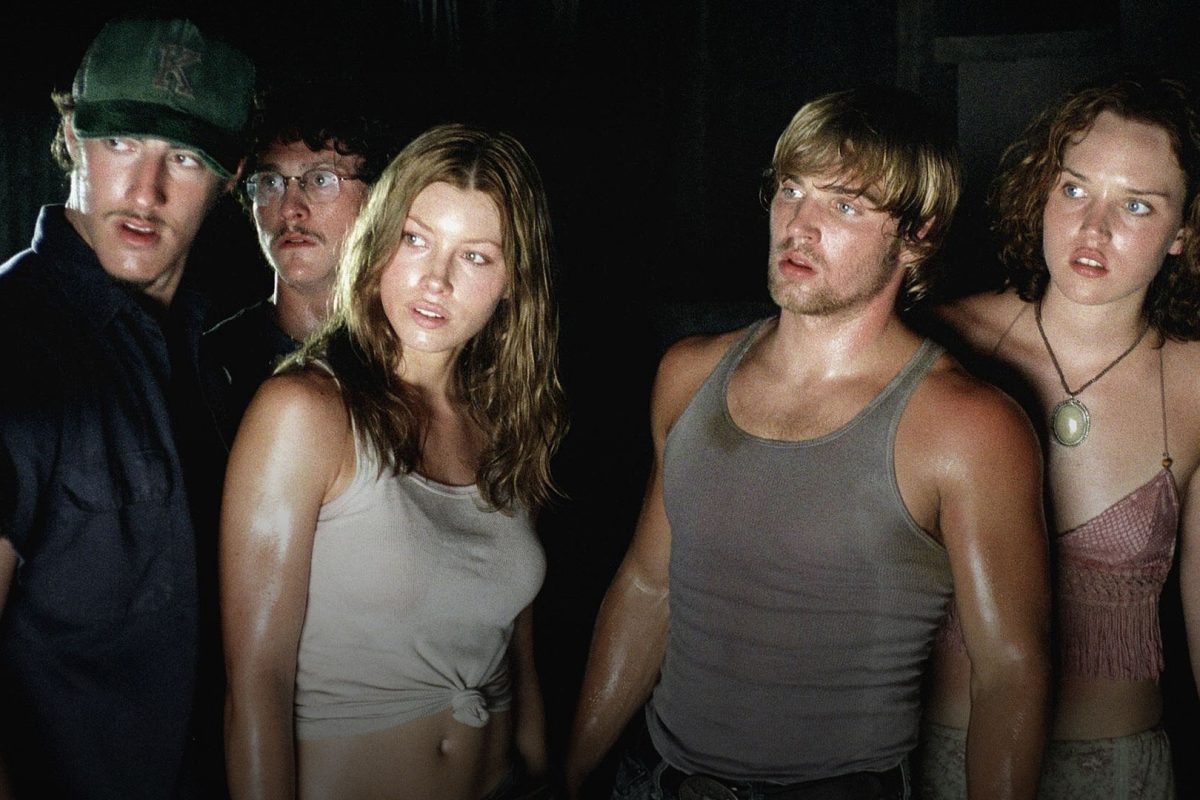
Enter Our Halloween Giveaway!
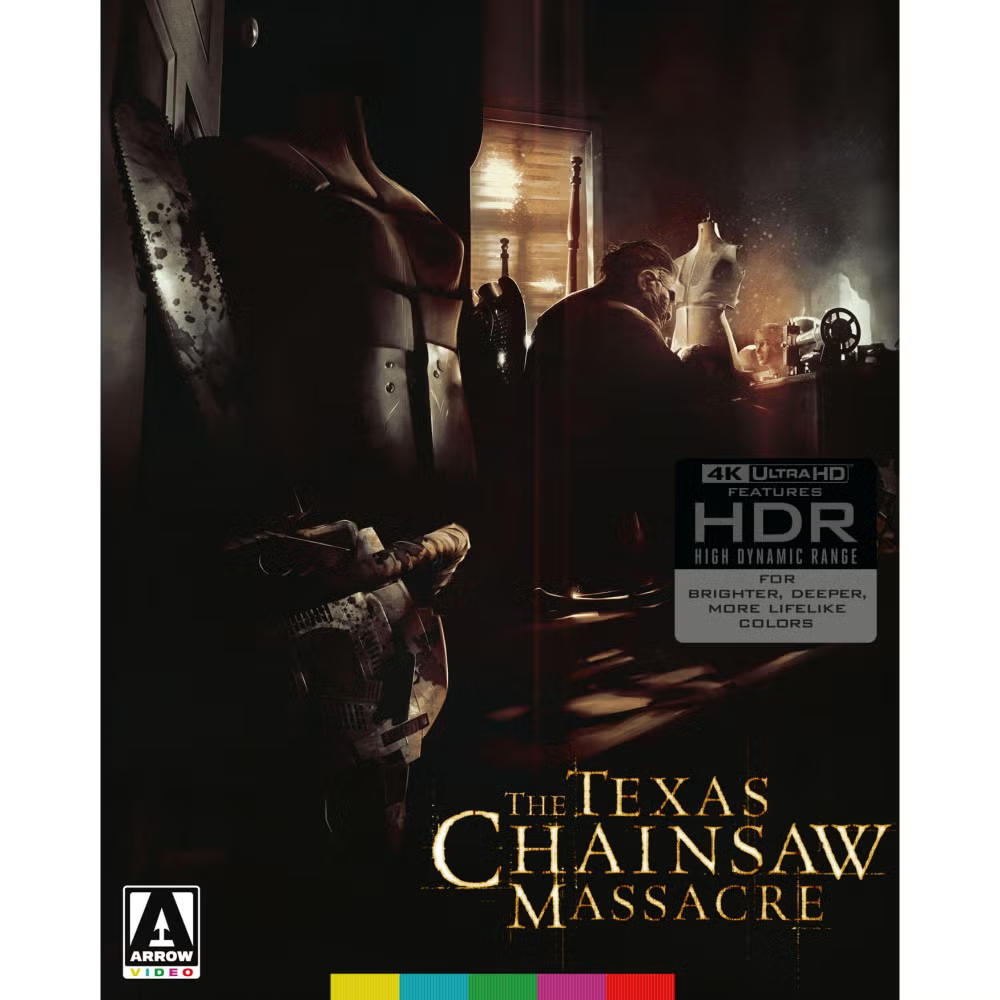
How to Enter:
Step 1. Make sure to FOLLOW US ON FACEBOOK AND JOIN OUR FACEBOOK GROUP!
Step 2. LIKE AND SHARE the giveaway post!
Step 3. This is the most important step, email us at contact@horrorpress.com with your FULL Facebook name (so we can verify you’re in the group) and who your favorite character is from the Texas Chainsaw franchise.
**Giveaway entries are limited to addresses in the United States.**
**All entries must be 18 or older to enter**
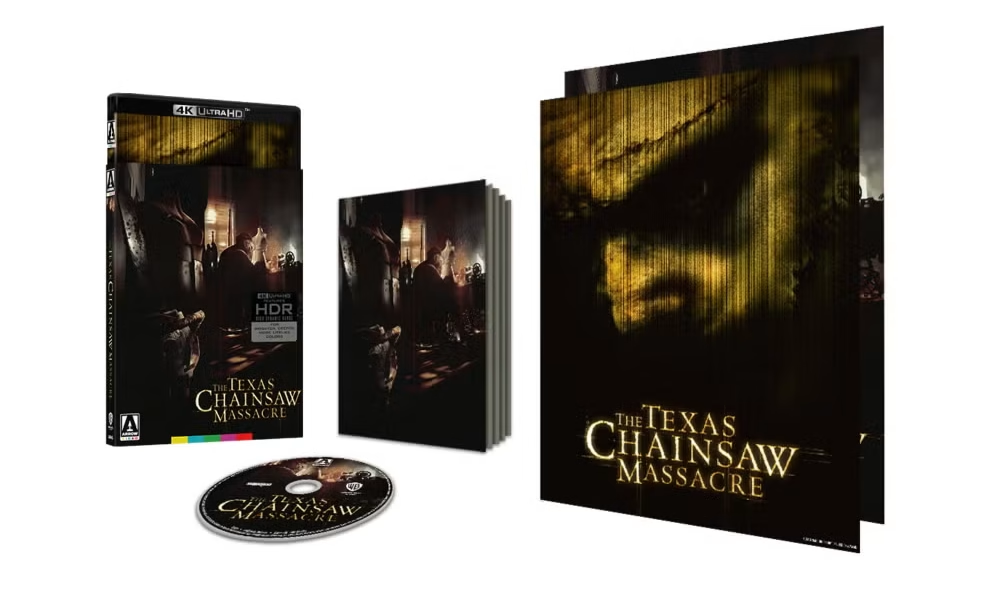
What You’ll Win
The Texas Chainsaw Massacre (2003) Limited Edition 4K UHD from Arrow Video
- 4K (2160p) Ultra HD Blu-ray presentation in Dolby Vision (HDR10 compatible)
- Original DTS-HD MA 7.1 and 5.1 surround audio and lossless stereo audio
- Optional English subtitles for the deaf and hard of hearing
- Brand new audio commentary with Dread Central co-founder Steve “Uncle Creepy” Barton and co-host of The Spooky Picture Show podcast Chris MacGibbon
- Archival audio commentary with director Marcus Nispel, producer Michael Bay, executive producers Brad Fuller and Andrew Form and New Line Cinema founder Robert Shaye
- Archival audio commentary with Marcus Nispel, director of photography Daniel Pearl, production designer Greg Blair, art director Scott Gallager, sound supervisor Trevor Jolly and composer Steve Jablonsky
- Archival audio commentary with Marcus Nispel, Michael Bay, writer Scott Kosar, Brad Fuller, Andrew Form and actors Jessica Biel, Erica Leerhsen, Eric Balfour Jonathan Tucker, Mike Vogel and Andrew Bryniarski
- Reimagining a Classic, a brand new interview with director Marcus Nispel
- Shadows of Yesteryear, a brand new interview with cinematographer Daniel Pearl
- The Lost Leatherface, a brand new interview with actor Brett Wagner
- Masks and Massacres, a brand new interview with makeup effects artist Scott Stoddard
- Chainsaw Symphony, a brand new interview with composer Steve Jablonsky
- Chainsaw Redux: Making A Massacre, a making-of documentary
- Ed Gein: The Ghoul of Plainfield, an in-depth look at the infamous killer who inspired the character of Leatherface
- Severed Parts, a look at the cutting room floor and some of the scenes excised from the final edit
- Deleted scenes including an alternate opening and ending
- Screen tests for Jessica Biel, Eric Balfour and Erica Leerhsen
- Behind-the-scenes featurette
- Cast and crew interviews
- Theatrical trailers and TV spots
- Concept art galleries
- Reversible sleeve featuring original and newly commissioned artwork by Aaron Lea
- Double-sided foldout poster featuring original and newly commissioned artwork by Aaron Lea
- Illustrated collector’s booklet featuring new writing on the film by Michael Gingold
Misc
NYCC 2025 Horror Highlights: A Sneak Peek at ‘The Lost Boys’ Musical, ‘Resident Evil: Requiem,’ and More!

As soon as New York Comic Con announced that its 2025 theme would be “haunted,” I started lacing up my comfy shoes and making a beeline for the Javitz Center! Horror has always been represented at the con, but it felt fitting that it should play a central role in this year’s event at a time when the genre seems more popular than ever.
From beloved family-friendly properties like The Nightmare Before Christmas to pants-dampening titles like the upcoming Resident Evil: Requiem, horror appeared in countless shapes and forms. Here are all the best and scariest insights I gleaned from the show floor, panel rooms, and pop-ups of New York Comic Con 2025!
Our NYCC 2025 Horror Highlights
Resident Evil: Requiem Is Going to Test Your Bladder Strength
Full disclaimer: I’m not a gamer. I’m honestly pretty bad at games, which made my Resident Evil: Requiem play session all the more frightening because I was convinced that everyone around me would realize I’m a fraud. But with easy-to-grasp controls, even for a newb like me, the latest installment in the iconic horror franchise quickly sucked me in and left me on edge for entirely different reasons.
During my 30-minute session, I was introduced to FBI analyst Grace Ashcroft, Requiem’s central character. She swims to consciousness to find herself strapped upside down on a gurney with a needle in her arm, siphoning her blood. After Grace managed to free herself, the controls were handed over to me to explore the creepy facility through Grace’s eyes, looking for a fuse. Some spaces were bathed in red light; others were lit only by flickering bulbs that left me white-knuckling the controller, waiting for something to emerge from the shadows and swallow me whole, not helped by Grace’s anxious, stuttering breathing in my ear.
I took a moment to appreciate how detailed video games have become since my childhood experiences playing Evil Dead: Hail to the King on the original PlayStation (seriously, you can see the dust drifting in beams of light now?!), only for the sound of movement somewhere in the facility to yank me back to the present. I renewed my frantic search for the fuse, only to run blindly into a pitch-black room and encounter something enormous that dragged me into the darkness. Sorry, Grace!
You can find out what happens next when Resident Evil: Requiem releases for the PlayStation 5, Xbox Series X|S, PC, and Nintendo Switch 2 on February 27, 2026.
Megan Fox Is Among the New Cast Members in Five Nights at Freddy’s 2—And Blumhouse Hasn’t Given Up on Its Other m3gan Yet
Blumhouse made several announcements at their NYCC panel, most notably that Megan Fox (Jennifer’s Body) is voicing Toy Chica in director Emma Tammi’s highly anticipated sequel Five Nights at Freddy’s 2, coming to theaters on December 5. Other new additions to the cast include YouTuber Matthew Patrick, aka MatPat, who cameoed in the first movie and will voice Toy Bonnie, and Kellen Goff, who has voiced multiple characters in the game series and will now lend his pipes to Toy Freddy.
I’m interested in Five Nights at Freddy’s 2, not least because my best friend is terrified of the franchise and makes a wildly entertaining moviegoing companion—but I’m more interested in the future of another Blumhouse franchise, M3GAN. After the sequel underperformed, likely due in part to its hard genre pivot away from horror and into action territory, the future of the killer doll is uncertain. But in a special industry presentation on “The Business of Fear,” Jason Blum revealed that “we’re all working to keep M3GAN alive,” adding that Blumhouse is exploring other potential mediums before trying to resurrect her on film.
Does that mean a M3GAN video game might come our way in the future, or perhaps a TV series? I don’t know, but I have a feeling this isn’t the last we’ve seen of the silicone diva.
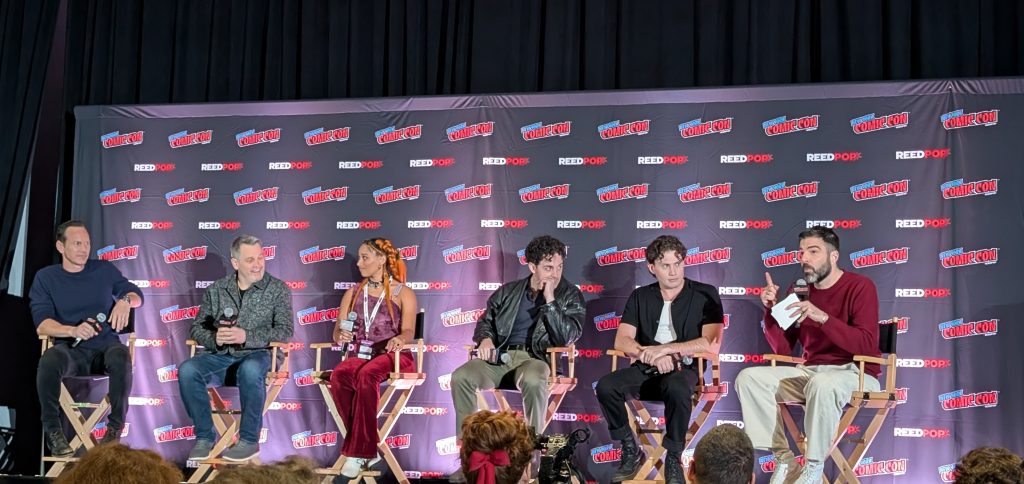
Photo taken by Samantha McLaren.
The Lost Boys: A New Musical Will Feature Flying Stunts and a Live Vampire Band
My queer heart is a sucker for musical adaptations of horror films I love, so you can be certain that I’ll be heading down to the Santa Carla Boulevard—aka Broadway’s Palace Theater—for The Lost Boys: A New Musical, which begins previews on March 27, 2026. At their NYCC panel, producer Patrick Wilson (The Conjuring franchise), director Michael Arden (Maybe Happy Ending), and cast members LJ Benet, Ali Louis Bourzgui, and Maria Wirries revealed why they feel Joel Schumacher’s 1987 classic translates so well to the stage, and what audiences can look forward to.
“There’s something that I see with both horror movies, musicals, and superhero movies—there’s an element of melodrama that’s really rewarding,” says Wilson, who began his career in musical theater and worked with Schumacher on the director’s 2004 film adaptation of The Phantom of the Opera. “Some people view it as camp, but there’s a reality of it being heightened that felt like this story cemented itself so much to being a musical.”
“They’re a biker gang, after all, and there’s a level of theatricality to that in and of itself,” says Arden. “Our biker gang also happens to play instruments.”
That’s right: the vampires will be playing instruments live on stage, which made casting twice as hard. Ali Louis Bourzgui, who plays David, the character portrayed by Kiefer Sutherland in the film, reveals that he plays guitar. And that wasn’t the only unusual request in the casting call: auditions included a flying test. (Presumably wires were involved, unless Arden has found himself a real cabal of vampires in his cast.)
Other highlights that fans can look forward to include killer music from one of Arden’s favorite bands, The Rescues. You can listen to the song “Have to Have You” right now, featuring instrumentals from Slash. The director also teases that many fan-favorite moments from the film will feature in some way in the musical, including the bridge scene and, yes, even the sexy saxophone guy.
Greg Nicotero’s Guts & Glory Marks a New Challenge for a Legend of the Business
If you like looking at gnarly practical effects in horror movies, chances are you’re familiar with Greg Nicotero’s work, whether you realize it or not. The legendary SFX artist has worked on everything from George Romero’s Day of the Dead and Sam Raimi’s Evil Dead II to Kill Bill and, more recently, The Walking Dead. The impressive extent of his resume was made clear at the panel “Shudder is Here to Scare the S*** Out of You,” in which almost any film mentioned by the other panelists was met by a small smile and a humble murmur of “worked on that” into the mic, often followed by a wild anecdote. Nicotero seems like the most interesting man in the world to grab a drink with, and his new horror competition show for Shudder—Guts & Glory—will let us see more of the man behind the makeup brush.
“Guts & Glory is one of the most fun times I’ve had on a show,” Nicotero says, teasing that the series is “part Sam Raimi, part Halloween Horror Nights, and part Survivor.”
In the six-episode first season, contestants are dropped into an Alabama swamp, where there’s an urban legend about an evil spirit. “One of the contestants gets possessed by the evil spirit, people start dying off, but in the meantime, they’re still competing and there’s a prize,” Nicotero explains.
Guts & Glory is effects-heavy, which was challenging to do in an unscripted series relying on real people’s real-time reactions. “You do a movie, you can cut and try it again,” Nicotero explains. “[This] was completely out of my wheelhouse and out of my comfort zone, but I’m really, really proud of it.”
Nicotero’s Creepshow was one of the first original shows to debut on Shudder, so he’s truly part of the DNA of the horror streamer, which celebrated its 10th anniversary this year. Guts & Glory premieres on October 14 as part of Shudder’s Season of Screams programming.
Horror Short The Littles Deserves the Big-Screen Feature Treatment
Some short films are perfectly suited to their bite-sized format, while others contain the seeds of something much bigger. At the New York Premiere of The Littles, a new short written and directed by American Horror Story producer Andrew Duplessie, I could immediately see the potential for the feature film that Duplessie hopes to make.
Equal parts charming and unsettling, The Littles stars M3GAN’s Violet McGraw as a little girl with a loose floorboard in her bedroom. One night, a scuffling sound and a crack of light between the boards lead the little girl to discover that her family isn’t alone in the house…
Duplessie says The Littles was inspired by his own experiences growing up in a creaky old house with a no-doubt overactive imagination. The short features creepy-cute stop-motion animation from Anthony Scott (The Nightmare Before Christmas), puppets by Katy Strutz (Guillermo del Toro’s Pinocchio), and some truly adorable miniature sets by Aiden Creates, all blended perfectly with the live-action scenes. Check it out if it’s playing at a festival near you, and watch this space for a (fingers-crossed) future feature!
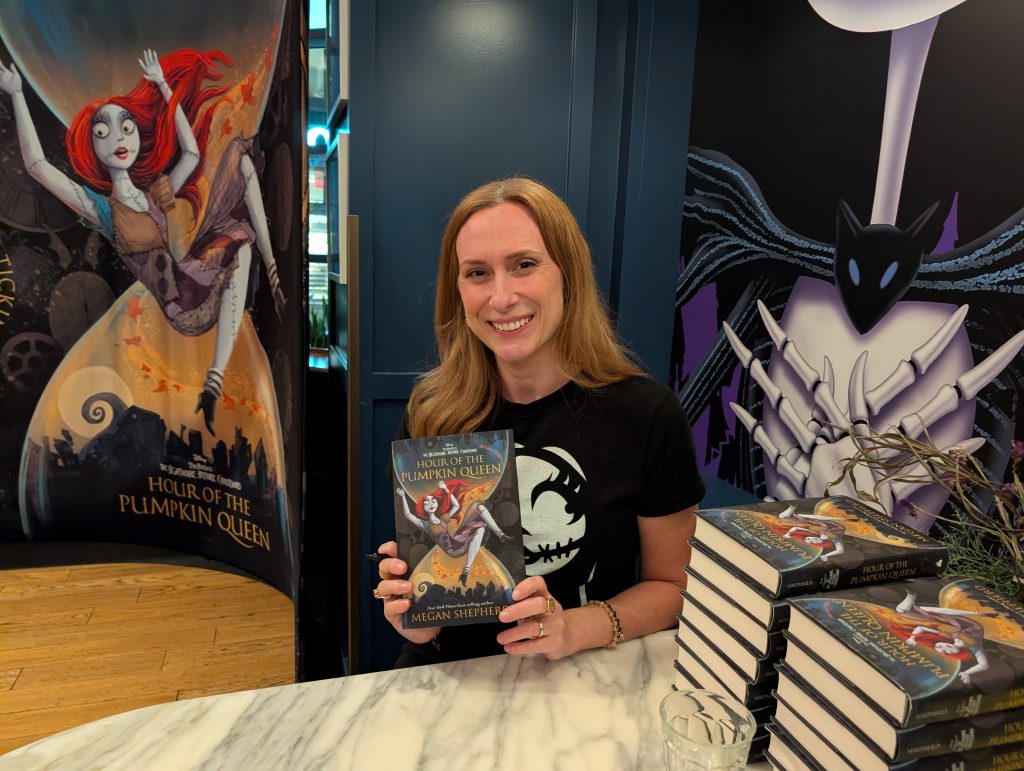
Photo taken by Samantha McLaren.
Disney Publishing’s New The Nightmare Before Christmas Tie-in Novel Welcomes Younger Fans into the Scary Fun
NYCC’s horror happenings weren’t all geared toward an adult audience. Disney Publishing took over Daily Provisions Manhattan West for a pop-up experience inspired by The Nightmare Before Christmas, featuring themed food and drinks like a delectable Pumpkin Potion coffee that I could honestly drink all season long.
At a media and creator event in the space, I took a look at the newly released Hour of the Pumpkin Queen from New York Times best-selling author Megan Shepherd, who also wrote the official novelization of The Nightmare Before Christmas for the film’s 30th anniversary in 2023. In this new tie-in novel, Sally and her rag doll apprentice, Luna, embark on a time-bending adventure to save Jack Skellington and Halloween Town after falling through a mysterious portal.
I was gifted a copy of the book by Disney, but all opinions are my own here. I’m looking forward to giving it a read during the inevitable Halloween hangover that takes place in November, before likely passing it on to my young nieces when they’re old enough. It’s a full novel, not a picture book, so definitely geared more toward a YA audience, but between the beautiful artwork on the cover and the seasonal theme, it might just be the perfect gift for the budding horror lover in your life.
That’s a wrap on New York Comic Con 2025! Be sure to bookmark Horror Press if you haven’t already so you never miss our coverage of conventions, festivals, and more.

























